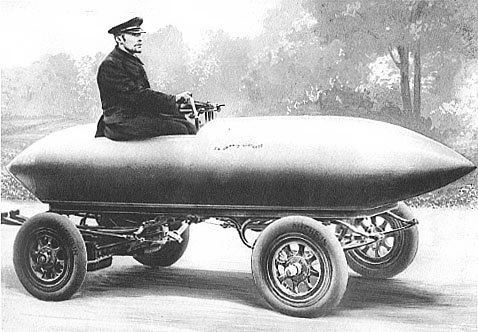Also called The Never Satisfied Engine Electrical | Production 1899 Length 3.80 metres (12.5 ft) | |
 | ||
Manufacturer Compagnie Internationale des transports automobiles électriques Width 1.56 metres (5 ft 1 in) | ||
La Jamais Contente (English: The Never Satisfied) was the first road vehicle to go over 100 kilometres per hour (62 mph). It was a Belgian electric vehicle with a light alloy torpedo shaped bodywork and batteries. The high position of the driver and the exposed chassis underneath spoiled much of the aerodynamics. The light alloy, called partinium, is an alloy of aluminium, tungsten and magnesium.
Contents
The land speed record was established on April 29 or May 1, 1899 at Achères, Yvelines near Paris, France. The vehicle had two direct drive Postel-Vinay 25 kW motors, running at 200 V drawing 124 Amperes each for about 68 hp, and was equipped with Michelin tires. Chassis number was n°25.
Driver
The vehicle was driven by the Belgian driver Camille Jenatzy. Camille was the son of Constant Jenatzy, a manufacturer of rubber products (rubber was still a novelty at the time). Camille had studied as an engineer, with an interest in electric traction automobiles. He became known for his record-breaking speed runs, and was nicknamed Le Diable Rouge ("The Red Devil") for the colour of his beard. He died in 1913, after being shot in a hunting accident.
Motivation
Willing to carve a place in the then promising Parisian electric carriage market, Jenatzy started a manufacturing plant which would produce many electric carriages and trucks. He fiercely competed against carriage maker Jeantaud in publicity stunts to see which made the fastest vehicles. In order to assure the triumph of his company, Jenatzy built a bullet shaped prototype, conceived by the carriage maker Rothschild in partinium (an alloy of laminated aluminum, tungsten and magnesium).
Speed Record
Jenatzy reached the speed of 105.882 kilometres per hour (65.792 mph), besting the previous record, held by Count Gaston de Chasseloup-Laubat driving a Jeantaud, who had attained 92.78 kilometres per hour (57.65 mph) on March 4, 1899. After this exploit the gasoline-fuelled combustion engine would increasingly supplant electric technology for the next century.
The Jamais Contente is now on display at the automobile museum in Compiègne, France.
